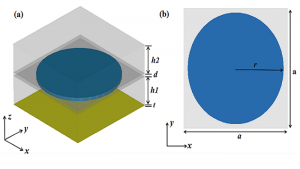There’s been a lot of research into 3D printing metamaterials over the years – due to their unique properties, they’ve been used to make everything from headphones and heart valve models to door locks and acoustic holograms, and maybe someday even our very own invisibility cloaks. But ten years ago, the metamaterial absorber (MA), a type of metamaterial with compact size and thin configuration meant to efficiently absorb electromagnetic radiation, was presented for the first time. Since that time, there have been numerous other MAs, including dual-, triple-, and multiband varieties and the wideband MA.
Because of its high absorption, wideband MAs are highly sought after for applications in sensing, nondestructive detection, and imaging. There are a few ways to increase the absorption bandwidth for wideband MAs, but it’s still tough to manufacture them.
A collaborative team of researchers from China’s Hefei University of Technology, the Beijing University of Chemical Technology, and Space Star Technology Co. Ltd. recently published a paper, titled “Wideband Metamaterial Absorbers Based on Conductive Plastic with Additive Manufacturing Technology,” that explains their development of a wideband MA based on 3D printed conductive plastic.
They believe that their new method is the first ever demonstration of a 3D printed wideband MA.
The abstract reads, “This paper proposes a wideband and polarization-insensitive metamaterial absorber (MA) based on tractable conductive plastic, which is compatible with an additive manufacturing technology. We provide the design, fabrication, and measurement result of the proposed absorber and investigate its absorption principle. The performance characteristics of the structure are demonstrated numerically and experimentally. The simulation results indicate that the absorption of this absorber is greater than 90% in the frequency range of 16.3−54.3 GHz, corresponding to the relative absorption bandwidth of 108%, where a high absorption rate is achieved. Most importantly, this additive manufactured structure provides a new way for the design and fabrication of wideband MAs.”
3D printing offers low cost, high efficiency, and convenience, but when it comes to making wideband MAs with the technology, it does lack an appropriately stable and tractable high-resistive film, as the typical materials used for this don’t work with 3D printing. But, the team thought that the absorption bandwidth of the MA could be increased by using highly conductive plastic.
“The proposed structure provides new opportunities for the design and fabrication of wideband MAs,” the researchers wrote.
The team’s proposed wideband MA is made of a patterned conductive plastic layer embedded in a layer of PLA, the bottom of which is covered with a copper ground film.
“First, a PLA layer with grooves is 3D printed,” the researchers wrote. “Next, the patterned conductive plastics were placed in these grooves, and then the PLA is continually printed above the patterned plastics to seal them. Finally, copper is pasted on the bottom surface of the PLA layer.”
Once they verified that the MA would work, they tested its absorption spectrum, which is greater than 90% from 16.3 to 54.3 GHz. The absorber has a thin thickness and high absorptivity, along with polarization insensitivity. The researchers used numerical simulations of the absorber to demonstrate its mechanism, efficiency, and the surface loss for both the copper ground layer and conductive plastic layer, the latter of which “contributes most power absorption of the absorber for both resonant modes.”
The researchers explained, “Hence, the conductive plastic layer plays an important role in the wideband absorption.”
The design was verified in a free space experiment, and the researchers used two horn antennas, connected to a network analyzer, measured the sample’s performance charactertistics in the 18−40 GHz frequency range. This showed that their MA design achieved “a good agreement between the simulated and measured results.”
The research team showed that they could save money and simplify things by 3D printing an effective, high-performance wideband MA based on conductive plastic. Their design strategy also made the 3D printed structure insensitive to wave polarization.
“This study is expected to reveal the potential applications of additive manufacturing technology in the realization of wideband electromagnetic wave absorbers,” the researchers concluded.
Co-authors of the paper are Yujiao Lu, Baihong Chi, Dayong Liu, Sheng Gao, Peng Gao, Yao Huang, Jun Yang, Zhiping Yin, and Guangsheng Deng.
Discuss this research and other 3D printing topics at 3DPrintBoard.com or share your thoughts in the Facebook comments below.
Subscribe to Our Email Newsletter
Stay up-to-date on all the latest news from the 3D printing industry and receive information and offers from third party vendors.
You May Also Like
Gorilla Sports GE’s First 3D Printed Titanium Cast
How do you help a gorilla with a broken arm? Sounds like the start of a bad joke a zookeeper might tell, but it’s an actual dilemma recently faced by...
Nylon 3D Printed Parts Made More Functional with Coatings & Colors
Parts 3D printed from polyamide (PA, Nylon) 12 using powder bed fusion (PBF) are a mainstay in the additive manufacturing (AM) industry. While post-finishing processes have improved the porosity of...
$25M to Back Sintavia’s Largest Expansion of Metal 3D Printing Capacity Since 2019
Sintavia, the digital manufacturing company specializing in mission-critical parts for strategic sectors, announced a $25 million investment to increase its production capacity, the largest expansion to its operations since 2019....
Velo3D Initiates Public Offering in a Bid to Strengthen Financial Foundations and Drive Future Growth
Velo3D (NYSE: VLD) has been among a number of publicly traded 3D printing firms that have attempted to weather the current macroeconomic climate. After posting a challenging financial report for 2023,...



































